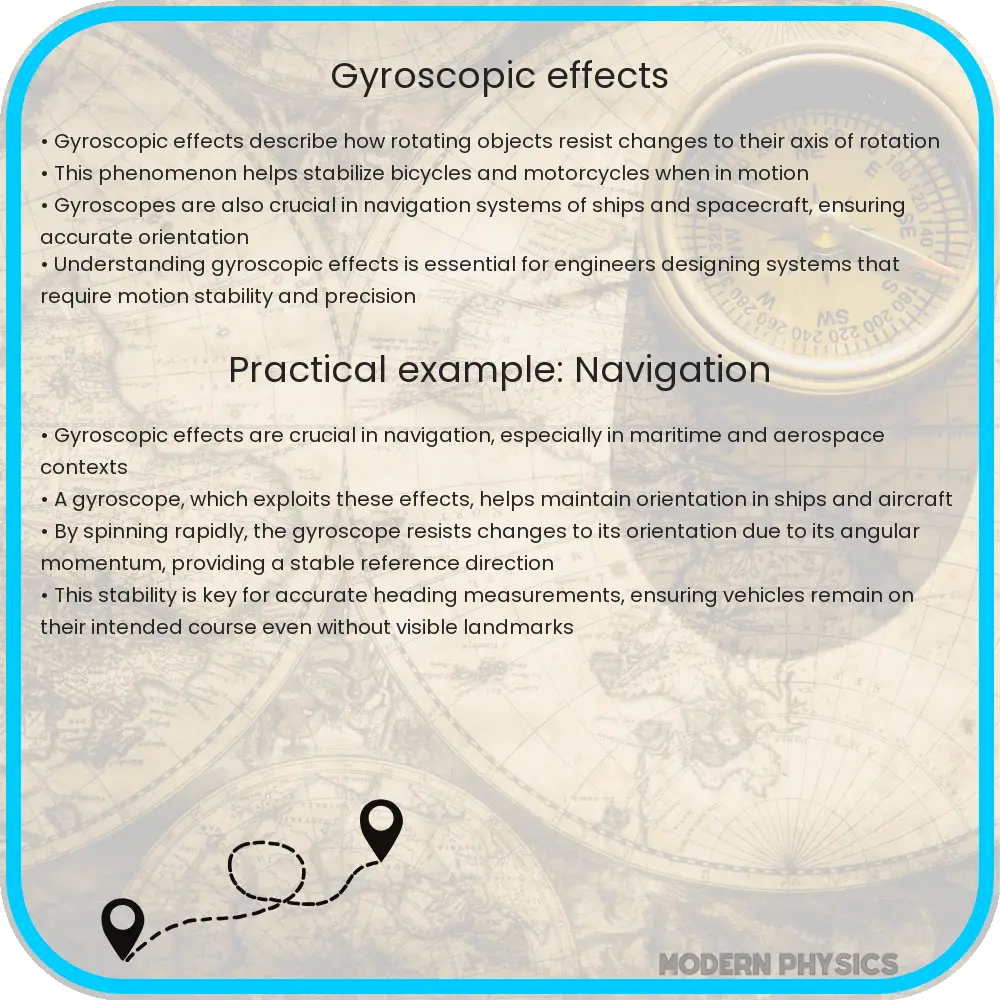Explore the fascinating world of gyroscopic effects, covering stability, precision, dynamics, and their applications in technology and engineering.

Gyroscopic Effects: Understanding Stability, Precision, and Dynamics
The concept of gyroscopic effects is pivotal in various fields of science and engineering, providing critical insights into stability, precision, and dynamic behavior. This phenomenon is primarily observed in rotating bodies, where it manifests as a resistance to changes in the axis of rotation. The principles governing these effects are rooted in fundamental physics, particularly in the conservation of angular momentum.
Basics of Gyroscopic Motion
At the heart of gyroscopic motion is a spinning disc or rotor, which, due to its rotation, maintains a steady orientation in space. This behavior is governed by the conservation of angular momentum, a principle stating that the angular momentum of a system remains constant if no external torque is applied. In mathematical terms, angular momentum (L) is expressed as L = Iω, where I is the moment of inertia and ω is the angular velocity.
Stability in Gyroscopes
One of the most remarkable attributes of gyroscopes is their ability to maintain stability. This property is extensively utilized in navigation systems, such as those in aircraft and ships. The gyroscopic effect ensures that the gyroscope’s axis of rotation remains fixed in space, regardless of the motion of the platform it’s mounted on. This principle is critical for inertial guidance systems where precise orientation information is essential.
Precision and Dynamic Response
The precision of gyroscopes in measuring rotation and maintaining orientation is another area where their impact is profound. In robotics and industrial machinery, gyroscopes contribute to enhanced precision and control. Their dynamic response to external forces and torques also plays a significant role in understanding and designing systems like stabilizers and rotational sensors.
Applications and Implications
The applications of gyroscopic effects span across various domains. In the realm of aerospace engineering, they are fundamental to the design of attitude control systems in spacecraft. Similarly, in consumer electronics, gyroscopes enable motion sensing and orientation detection in smartphones and gaming controllers. The underlying physics also finds relevance in studying Earth’s rotation and its geophysical implications.
Understanding the gyroscopic effects not only enhances our grasp of fundamental physics but also opens avenues for innovation in technology and engineering.
Advanced Gyroscopic Concepts
Delving deeper into gyroscopic effects, advanced concepts such as precession and nutation become significant. Precession is the phenomenon where the axis of a spinning gyroscope moves in a circular path under the influence of an external torque. This is best visualized in a gyroscope supported at one end, where the force of gravity induces a torque, causing the gyroscope’s axis to move in a precessional motion. The rate of precession is inversely proportional to the angular velocity of the gyroscope, a relationship described by the formula Ω = τ/Iω, where Ω is the precessional speed, τ the applied torque, and Iω the angular momentum.
Nutation, on the other hand, involves a slight oscillation of the gyroscope’s axis, superimposed on the precession. This is often a result of an initial disturbance in the gyroscope’s motion and gradually dampens over time. Both precession and nutation are critical in understanding the dynamic stability of rotating bodies in engineering and astrophysics.
Challenges and Innovations
While gyroscopes offer remarkable benefits, they also come with challenges, particularly in precision engineering. Mechanical gyroscopes, for instance, suffer from friction and wear, leading to a decline in accuracy over time. This has led to the development of optical and MEMS (Micro-Electro-Mechanical Systems) gyroscopes, which provide higher precision and durability. These advancements have revolutionized fields like autonomous vehicle navigation and drone technology.
In the realm of quantum mechanics, the exploration of quantum gyroscopes presents a frontier in understanding and manipulating quantum states for ultra-precise measurements. These developments signify the ongoing evolution of gyroscopic technologies and their applications.
Conclusion
The study of gyroscopic effects offers a fascinating intersection of physics, engineering, and technology. From stabilizing ships to guiding spacecraft, the principles of gyroscopy have been instrumental in numerous technological advancements. Understanding these effects not only underscores the importance of fundamental physics in practical applications but also inspires continual innovation in precision engineering and technology. As we delve deeper into the realm of quantum and optical gyroscopes, the future holds promising potential for even more precise and sophisticated applications, further demonstrating the remarkable versatility and impact of gyroscopic effects in science and technology.
